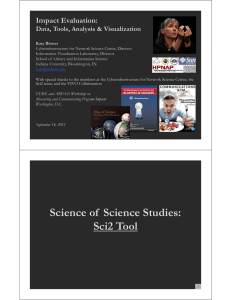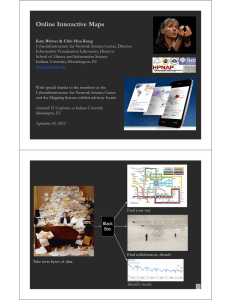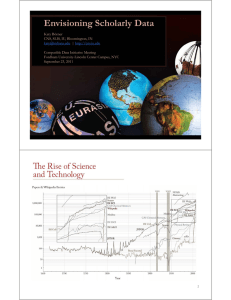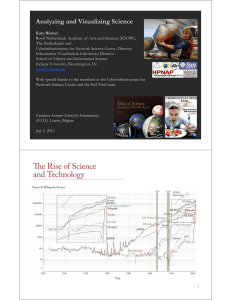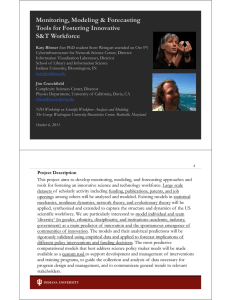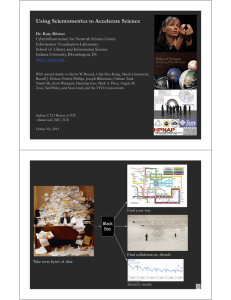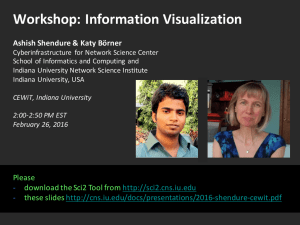Document 10771361
advertisement
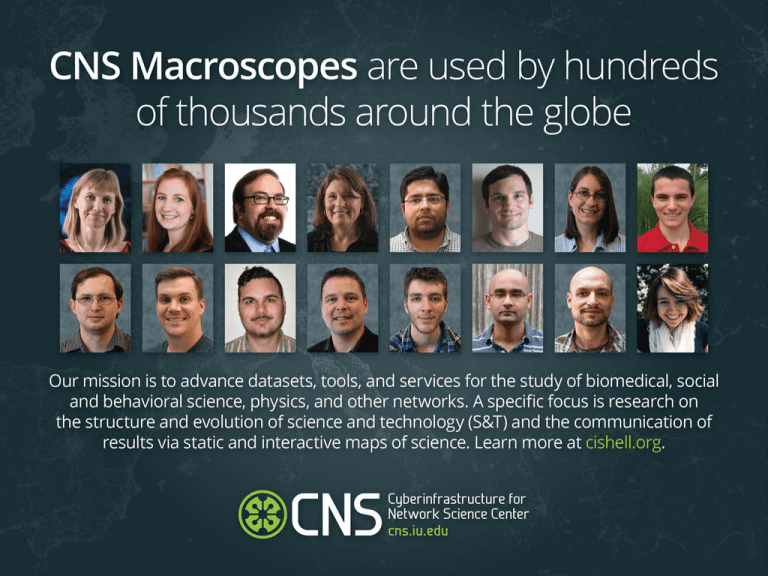
20+ CNS staff and students work on 20+ projects • Monitoring, Modeling, and Forecasting Tools for Fostering an Innovative S&T Workforce. NIH U01 GM098959-01 (Katy Börner & James P. Crutchfield, UC Davis) • Scaling Philanthropy: Providing New Insight About Million Dollar Gifts. Bill & Melinda Gates Foundation (Patrick Rooney, Una O. Osili) • Mapping the Emergence and Development of Scientific Disciplines. James S. McDonnell Foundation • Pathways: Sense-Making of Big Data. NSF ISE DRL-1223698 (Katy Börner, Adam V. Maltese, Joe E. Heimlich, Stephen Miles Uzzo, Paul Martin, and Sasha Palmquist) • Introducing the Science of Science (Sci2) Tool to the BBSRC Policy Evidence Team. BBSRC, UK. • … The Global 'Scientific Food Web' Mazloumian, Amin, Dirk Helbing, Sergi Lozano, Robert Light, and Katy Börner. 2013. "Global Multi-Level Analysis of the 'Scientific Food Web'". Scientific Reports 3, 1167. http://cns.iu.edu/docs/publications/2013-mazloumian-food-web.pdf Contributions: Comprehensive global analysis of scholarly knowledge production and diffusion on the level of continents, countries, and cities. Quantifying knowledge flows between 2000 and 2009, we identify global sources and sinks of knowledge production. Our knowledge flow index reveals, where ideas are born and consumed, thereby defining a global ‘scientific food web’. While Asia is quickly catching up in terms of publications and citation rates, we find that its dependence on knowledge consumption has further increased. From funding agencies to scientific agency: Collective allocation of science funding as an alternative to peer review Bollen, Crandall, Junk, Ding & Börner. 2014. EMBO Reports 15 (1): 1-121. Existing (left) and proposed (right) funding systems. Reviewers in blue; investigators in red. In the proposed system, all scientists are both investigators and reviewers: every scientist receives a fixed amount of funding from the government and discretionary distributions from other scientists, but each is required in turn to redistribute some fraction of the total they received to other investigators. http://scimaps.org/atlas_of_knowledge.html MEDLINE-Based Career Length Analysis • Dr. Katy Borner, Principal Investigator • Robert Light, Senior Systems Analyst, Database Administrator Career Length Questions • At what point in a career is High Impact and Transformative Science (HITS) produced? • Does the elimination of the mandatory retirement age influence the way that science and in particular HITS is produced? Career Duration Analysis • Can we disambiguate authors and identify careers from MEDLINE data? • What can we learn about not only the length of careers but how those careers progress from the MEDLINE data? • Based on Torvik and Smalheiser’s Author-ity dataset. Mean Number of Papers vs Career Length 140 Mean Number of Papers 120 100 80 60 40 20 0 0 10 20 30 40 Career Length (y) 50 60 70 Papers/Year vs Career Length 3 Mean Number of Papers 2.5 2 1.5 1 0.5 0 0 10 20 30 40 Career Length (y) 50 60 70 Open Questions • When are the high impact papers being written in the field of aging? (Early, middle or late career) • Is this consistent with medical science as a whole? BBSRC Biotechnology and Biological Sciences Research Council Grant Analysis Front-end filtering, data drill-down, animation over time Filter by: Analysis Type, Funding Types, Institutions, Research Topics, Categories Animation Analysis NETE A/V Proportional Symbol Map (Where) Temporal Map (When) Bimodal Map(Who) Map of Science (What) Front-end Framework MV* Framework to manage views, encapsulate data, testing, templates, etc. JSON Spec Visualization and Layout Pairing definition to match user fields to required fields for visualization. HTML5 and SVG items to render visualization. A Brief Look into Sci2 Tool’s Users and Research Michael Ginda Graduate Research Assistant Cyberinfrastructure for Network Science Center School of Informatics and Computing Indiana University Bloomington http://cns.iu.edu Overview of Tool and Development The Science of Science (Sci2) Tool is a modular toolset specifically designed for the study of science. It supports the temporal, geospatial, topical, and network analysis and visualization of scholarly datasets at the micro (individual), meso (local), and macro (global) levels. In development since 2009, with the latest release, Sci2 v.1.1 Beta, coming December 2013. Sci2 has logged 20,451 downloads, by over 11,170 user, over the last six years of development of development. Downloads by release: v 1.1 beta 5,705 v1.0 alpha 8,998 v0.5.2 alpha 775 v0.5.1 alpha 3,477 v0.5 alpha 379 v0.3 alpha 954 v0.2 alpha 82 v0.1 alpha 81 Brief Sci2 User Statistics Users by Job Category: Job Category Education (Faculty and Staff) Education (Student) Government Industry Not for Profit Other (blank) User Count 5,464 1,509 585 906 369 552 1,785 Users by Job Country (100 or more accounts activated): Country United States India United Kingdom Brazil Canada Germany Netherlands France China, People's Republic of Australia Colombia Mexico Italy Spain Japan Russia (blank) User Count 5463 473 404 372 286 258 213 205 194 161 159 156 135 109 109 106 531 2013 Accounts by Organizations (5 or more accounts activated) Organization User Count Indiana University 85 University of Michigan 18 UNAM 18 NIH 12 IUPUI 11 Northwestern University 9 University of illinois 8 University of Notre Dame 8 Freelance 8 USP 7 Purdue University 7 UFSC 6 Universidad Nacional de Colombia 6 UNICAMP 6 Organization User Count Private 6 Google 6 Columbia University 6 University of New Mexico 5 Virginia Tech 5 Wayne State University 5 Thomson Reuters 5 Universidad de Caldas 5 UC Berkeley 5 UDEA 5 University of Alberta 5 Irstea 5 Arizona State University 5 (blank) 2,464 A Look at Research Produced Using Sci2 Data collected using a citation search Reuters of Web of Science (WoS) by querying authors “Sci2 Team” resulted in 17 publications that used the Sci2 tool, between 2009 and 2014. WoS Research Areas Source Titles Research Areas # of Records % of Records INFORMATION SCIENCE LIBRARY SCIENCE 13 76.471 COMPUTER SCIENCE 12 70.588 PUBLIC ENVIRONMENTAL OCCUPATIONAL HEALTH 1 5.882 PHYSICAL GEOGRAPHY 1 5.882 METEOROLOGY ATMOSPHERIC SCIENCES 1 5.882 MEDICAL INFORMATICS 1 5.882 HEALTH CARE SCIENCES SERVICES 1 5.882 GEOGRAPHY 1 5.882 ENVIRONMENTAL SCIENCES ECOLOGY 1 5.882 ENGINEERING 1 5.882 ENDOCRINOLOGY METABOLISM 1 5.882 EDUCATION EDUCATIONAL RESEARCH 1 5.882 Source Titles # of Records % of Records SCIENTOMETRICS 7 41.176 WILEY INTERDISCIPLINARY REVIEWS CLIMATE 1 5.882 CHANGE PROCEEDINGS OF THE INTERNATIONAL CONFERENCE 1 5.882 ON SCIENTOMETRICS AND INFORMETRICS PROCEEDINGS OF ISSI 2011 THE 13TH CONFERENCE 1 5.882 OF THE INTERNATIONAL SOCIETY FOR SCIENTOMETRICS AND INFORMETRICS VOLS 1 AND 2 OSTEOPOROSIS INTERNATIONAL 1 5.882 OCCUPATIONAL SAFETY AND HYGIENE II 1 5.882 JOURNAL OF THE AMERICAN SOCIETY FOR 1 5.882 INFORMATION SCIENCE AND TECHNOLOGY JOURNAL OF THE AMERICAN MEDICAL INFORMATICS 1 5.882 ASSOCIATION INTERNATIONAL JOURNAL OF INFORMATION 1 5.882 MANAGEMENT INTERNATIONAL JOURNAL OF GEOGRAPHICAL 1 5.882 INFORMATION SCIENCE INTERNATIONAL JOURNAL OF ELECTRICAL 1 5.882 ENGINEERING EDUCATION ASLIB JOURNAL OF INFORMATION MANAGEMENT 1 5.882 UCSD map of Science showing Domains where Sci2 has been used A Look at Research Produced Using Sci2 Co-Author Network of Research citing Sci2 Tool. 40 authors wrote 17 papers. Papers were cited for a 60 times, with each paper being cited an average of 3.88 times. Each papers had between 1 and 4 authors. The article with the highest citation, 28, count is for the article: Cobo, M. J.; Lopez-Herrera, A. G.; Herrera-Viedma, E. (2011). Science Mapping Software Tools: Review, Analysis, and Cooperative Study Among Tools. JOURNAL OF THE AMERICAN SOCIETY FOR INFORMATION SCIENCE AND TECHNOLOGY, 62:7 (1382-1402). A Look at Research Produced Using Sci2 Topic Network of Research citing the Sci2 Tool This network shows the topic map created by looking at the major concepts extracted from the 17 citations’ Titles and Abstracts. The network was reduced using the MST Pathfinder Network Scaling to highlight major relationships between concepts. The network was further reduced to show only edge relationships with a weight greater than two. Nodes are sized and colored by the number of citations that they appear (between 2 and 17 citations. Data-based Projects at CNS • Robert Light, Senior Systems Analyst, Database Administrator BBSRC ProQuest • Collaboration to explore dissertation data Modeling the Scientific Workforce • NIH Project exploring the movement of doctoral recipients through their careers Aging in the Scholarly Workforce • Collaboration with Ohio State University and NBER (Boston) • Exploring the effects of aging and the abolition of mandatory retirement on the scientific community and the creation of High Impact and Transformative Science (HITS) Other collaborations and projects • • • • SciELO (Brazil) TDAmeritrade SEAD VIVO – with Thomson Reuters/CONVERIS CNS: Toward Sustainable Software Development Daniel Halsey Senior Software Engineer CNS CNS: Toward Sustainable Development The Problem Non-repeatable practices Orphaned code Academic turnover Under-documented “standards” Short-term view Outdated documentation Latest-and-greatest mentality CNS: Toward Sustainable Development Sustainable Development Long-term view of systems Better for code Better for users Repeatable practices Better for developers Testable code Standardized platforms Replaceable components CNS: Toward Sustainable Development Sustainable Development Practices Agile techniques Meaningful communication Mindset Tools Revision control Work tracking Continuous integration Frameworks that work CNS: Toward Sustainable Development Key elements • Git workflow – – Gitflow Github Workflow • Fully test-backed development – – – Will be adding unit and integration tests as part of refactoring and updating efforts, as well as new development Potential for Test-Driven Development/Behavior-Driven Development Will facilitate Continuous Integration • Continuous Integration – – Fast, automated testing and deployment of the latest changes Faster regression discovery, faster bug fixes MOOC Visual Analytics Empowering teachers, students, researchers, and platform developers of Massive Open Online Courses Robert Light, Scott Emmons, Katy Börner Demographic Data - age, gender, education level, location Activity Data - content accessed, usage path, timestamps Performance Data - assessment scores, by question breakdown Survey Data - student intent, previous experience, feedback Related Work Daniel T. Seaton, Yoav Bergner, Isaac Chuang, Piotr Mitros, and David E. Pritchard. 2014. Who does what in a massive open online course?. Commun. ACM 57, 4 (April 2014), 58-65. DOI=10.1145/2500876 http://doi.acm.org/10.1145/2500876 Related Work From Canvas Guides. Licensed under a Creative Commons Attribution-NonCommercialShareAlike 4.0 International License (https://creativecommons.org/licenses/by-nc-sa/4.0/) Our Work (Published Textbook) Börner, Katy, and David E. Polley. 2014. Visual Insights: A Practical Guide to Making Sense of Data. Cambridge, MA: The MIT Press. Our Work (Working Paper)
